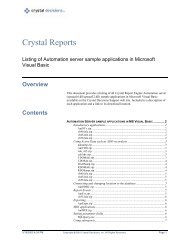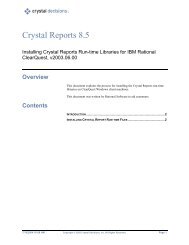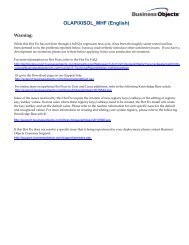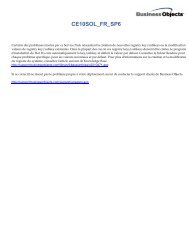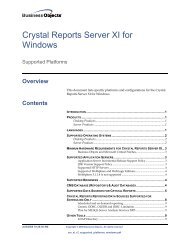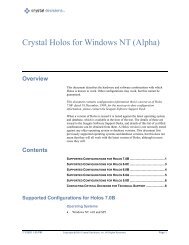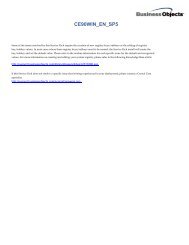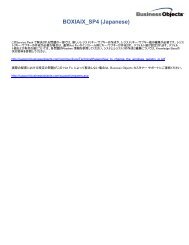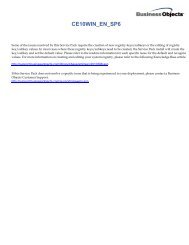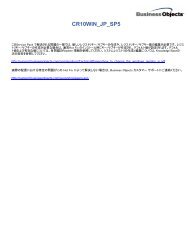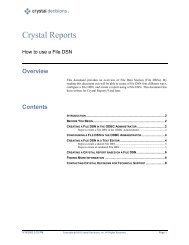Crystal Reports™ 8.5 Developer's Guide
Crystal Reports™ 8.5 Developer's Guide
Crystal Reports™ 8.5 Developer's Guide
Create successful ePaper yourself
Turn your PDF publications into a flip-book with our unique Google optimized e-Paper software.
The Best Tool for Your Needs<br />
We’ve ensured backward compatibility in <strong>Crystal</strong> Reports 8 to allow you to<br />
leverage applications created in the previous version. However, the <strong>Crystal</strong> Report<br />
Automation Server no longer exposes all of the events and properties of the Report<br />
Engine in <strong>Crystal</strong> Reports 8. Because the Report Designer Component is COMbased,<br />
and an evolution of the <strong>Crystal</strong> Reports Automation Server, you will find it<br />
easy to migrate from the <strong>Crystal</strong> Reports Automation Server to the RDC.<br />
Report Designer Component (RDC)<br />
The RDC—introduced in June 1998 as a component of <strong>Crystal</strong> Reports—represents<br />
a major reengineering of the <strong>Crystal</strong> Report Print Engine. Unlike any of its<br />
predecessors, the RDC is not a wrapper; it exposes all Report Engine objects<br />
directly without any translation. The RDC is based on the same object model as the<br />
<strong>Crystal</strong> Report Automation Server. Because it is not a wrapper, the RDC is a much<br />
more efficient COM object that supports features such as dual interface, providing<br />
a more efficient way of making calls to the Report Engine.<br />
The primary advantage of using the RDC over other developer tools within <strong>Crystal</strong><br />
Reports is its code writing and formatting capabilities in popular development<br />
environments such as Visual Basic. The RDC provides events that enable you to<br />
manipulate the report at runtime. Within these event handlers, you can access text<br />
or field objects to modify the output of a report based on user input. Setting text in<br />
text objects or field objects, or dynamically changing pictures in picture objects, are<br />
added features unique to this interface.<br />
The Best Tool for Your Needs<br />
We recommend that you use the RDC to take advantage of the best functionality<br />
and features available. While we support applications created using other tools<br />
like the OCX and the <strong>Crystal</strong> Report Print Engine APIs, the RDC offers more power<br />
and is easier to use.<br />
New features of the <strong>Crystal</strong> Report Print Engine are only available through the<br />
RDC. If you’d like to integrate them into your applications, you must change the<br />
code. Links to resources (technical briefs and tutorials) to help you migrate to the<br />
RDC are located on the Seagate Software Developer Zone web site.<br />
Visit the Seagate Software Developers Zone at<br />
http://www.seagatesoftware.com/products/dev_zone<br />
to find information on the resource that best suits your needs. Chapter 9, “Migrating<br />
to the RDC from the OCX” on page 119 of this guide shows you how to move quickly<br />
to the RDC from the OCX.<br />
TheRDCisthepremiumdevelopmentmethod,anditwillcontinuetobeenhanced<br />
for developers. The latest version of the RDC is included in <strong>Crystal</strong> Reports <strong>8.5</strong>.<br />
14 <strong>Crystal</strong> Reports Developer’s <strong>Guide</strong>



